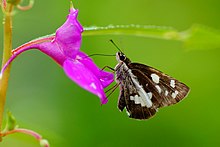Udaspes folus
| Udaspes folus | |
|---|---|
 |
|
| Scientific classification | |
| Kingdom: | Animalia |
| Phylum: | Arthropoda |
| Class: | Insecta |
| Order: | Lepidoptera |
| Family: | Hesperiidae |
| Genus: | Udaspes |
| Species: | U. folus |
| Binomial name | |
|
Udaspes folus (Cramer, 1775) |
|
The Grass Demon Udaspes folus is a small but prominent butterfly found in India that belongs to the Skippers, or Hesperiidae family. It is regarded as an occasional pest of ginger and turmeric.
The Grass Demon (Udaspes folus) is a small butterfly with a wingspan of about 4 to 4.8 cm. It is black with a large white spot on the upperside of the hindwing and several smaller whites spots on the forewing. The underside of its wings is mostly white with brown edges and spots.
Sri Lanka, South India to Saurashtra, Maharashtra, Gujarat, Madhya Pradesh, Uttar Pradesh, West Bengal, Himachal Pradesh to North East India and onto Myanmar, China, Thailand, Malaysian Peninsula, Singapore, Indonesia, Sumbawa. Australia.
Not Rare in India. Rare or Very Rare in certain parts of its global range. This butterfly is seen chiefly during the monsoon, perhaps due to its larval host plants growing at this time of the year.
The Grass Demon is to be found in deciduous and semi-evergreen forests. It prefers the edges of open spaces rather than the deep forest shade or open sunlight. It is most abundant in the more open regions of hilly jungle. It is also encountered on the plains at some distance from such terrain. It occurs up to 8000 feet in the hills of South India and up to 5000 feet in the Himalayas.
The Grass Demon prefers forest edges or clearings where dappled light is present. Its black and white colouration may have evolved to take advantage of the dappled light in these areas. The pied pattern which seems prominent in the open is effectively disruptive in the shade and the butterfly is difficult to locate once it settles down.
It is a bold insect and not easily disturbed. It usually flies in the shade among bushes and under trees keeping low and close to the ground. From time to time, it takes short flights, and, occasionally, much longer excursions into the open clearings. Its flight is quick and the path is very erratic making it very difficult to track when in flight.
Under side
Upperside
mating pair
As prey of a crab spider
When basking it sits on the upperside of leaves of herbs or bushes with its hindwings pressed flat against the surface and its forewings held half open at an angle above the hindwings.
This butterfly also has a unique wing flashing display most often seen just after it has alighted on a leaf. It will move its hindwings down toward the leaf surface. When the hindwings are about halfway down the forewings also start moving downwards. On the upward beat both wings are moved simultaneously till the hindwings come together. Then it again begins the downward beat. Each beat is performed very slowly and the butterfly is very conspicuous during this time.
...
Wikipedia
